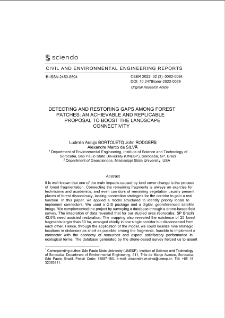Zielonogórska Biblioteka Cyfrowa udostępnia 65 391 obiektów cyfrowych
Obiekt
Tytuł: Detecting and Restoring Gaps Among Forest Patches: AN Achievable and Replicable Proposal to Boost the Landscape Connectivity
Autor:
Bortoleto, Ludmila Araujo ; Rodgers, John ; Silva, Alexandre Marko da
Data wydania:
Typ zasobu:
Współtwórca:
Tytuł publikacji grupowej:
Abstract:
It is well known that one of the main impacts caused by land cover change is the process of forest fragmentation. Connecting the remaining fragments is always an exercise for technicians and academics, and even corridors of remaining vegetation usually present places of forest discontinuity, lacking connection strategies for the corridor to gain a real function. ; In this paper, we applied a model structured to identify priority locals to implement connectors. We used a GIS package and a digital, georeferenced satellite image. We complemented the project by surveying a database through a drone-based field survey. The integration of data revealed that for our studied area (Sorocaba, SP Brazil) 42.5% need assisted restoration. The mapping also revealed the existence of 25 forest fragments larger than 50 ha, arranged chiefly in one single corridor but disconnected from each other. ; Hence, through the application of the model, we could localize nine strategic locations in distances as short as possible among the fragments, feasible to implement a connector with the economy of resources and expect satisfactory performance in ecological terms. The database generated by the drone-based survey helped us to assert the effectiveness of the model in choosing areas that require assisted restoration to reestablish the connection of the landscape.
Opis:
tytuł dodatkowy: Prace z Inżynierii Lądowej i Środowiska
Wydawca:
Zielona Góra: Oficyna Wydawnicza Uniwersytetu Zielonogórskiego
Format:
Identyfikator zasobu:
DOI:
Strony:
Źródło:
Civil and Environmental Engineering Reports (CEER), no 32, vol. 3
Jezyk:
Licencja CC BY-NC-ND 3.0:
Prawa do dysponowania publikacją:
Biblioteka Uniwersytetu Zielonogórskiego
Kolekcje, do których przypisany jest obiekt:
- Zielonogórska Biblioteka Cyfrowa > Repozytorium > Jednostki organizacyjne > Wydział Budownictwa, Architektury i Inżynierii Środowiska
- Zielonogórska Biblioteka Cyfrowa > Repozytorium > Typy utworów > Artykuły
- Zielonogórska Biblioteka Cyfrowa > Repozytorium > Czasopisma naukowe i serie wydawnicze UZ > Civil and Environmental Engineering Reports (CEER) > Civil and Environmental Engineering Reports (CEER) (2022)
Data ostatniej modyfikacji:
6 lip 2023
Data dodania obiektu:
30 mar 2023
Liczba wyświetleń treści obiektu:
141
Wszystkie dostępne wersje tego obiektu:
https://zbc.uz.zgora.pl/publication/79992

